our water continues to be healthy and exceed all Safe Drinking ...
our water continues to be healthy and exceed all Safe Drinking ...
our water continues to be healthy and exceed all Safe Drinking ...
- No tags were found...
You also want an ePaper? Increase the reach of your titles
YUMPU automatically turns print PDFs into web optimized ePapers that Google loves.
(B) Inorganic contaminants, such as salts <strong>and</strong> metals, which can <strong>be</strong> natur<strong>all</strong>y-occurring or result<br />
from urban s<strong>to</strong>rm <strong>water</strong> runoff, industrial or domestic waste<strong>water</strong> discharges, oil <strong>and</strong> gas<br />
production, mining or farming.<br />
(C) Pesticides <strong>and</strong> herbicides, which may come from a variety of s<strong>our</strong>ces such as agriculture,<br />
urban s<strong>to</strong>rm <strong>water</strong> runoff, <strong>and</strong> residential uses.<br />
(D) Organic chemical contaminants, including synthetic <strong>and</strong> volatile organic chemicals, which<br />
are by-products of industrial processes <strong>and</strong> petroleum production, <strong>and</strong> can also come from gas<br />
stations, urban s<strong>to</strong>rm <strong>water</strong> runoff, <strong>and</strong> septic systems.<br />
(E) Radioactive contaminants, which can <strong>be</strong> natur<strong>all</strong>y occurring or <strong>be</strong> the result of oil <strong>and</strong> gas<br />
production <strong>and</strong> mining activities.<br />
In this table you will find many terms <strong>and</strong> abbreviations you might not <strong>be</strong> familiar with. To help<br />
you <strong>be</strong>tter underst<strong>and</strong> these terms we've provided the following definitions:<br />
Initial Distribution System Evaluation (IDSE): An important part of the Stage 2 Disinfection<br />
Byproducts Rule (DBPR). The IDSE is a one-time study conducted by <strong>water</strong> systems <strong>to</strong> identify<br />
distribution system locations with high concentrations of trihalomethanes (THMs) <strong>and</strong> haloacetic<br />
acids (HAAs). Water systems will use results from the IDSE, in conjunction with their Stage 1<br />
DBPR compliance moni<strong>to</strong>ring data, <strong>to</strong> select compliance moni<strong>to</strong>ring locations for the Stage 2<br />
DBPR.<br />
Not Applicable - (N/A)<br />
"ND" means not detected <strong>and</strong> indicates that the substance was not found by labora<strong>to</strong>ry analysis.<br />
Parts per million (ppm) or Milligrams per liter (mg/I) - one part by weight of analyte <strong>to</strong> 1<br />
million parts by weight of the <strong>water</strong> sample.<br />
Parts per billion (ppb) or Micrograms<br />
by weight of the <strong>water</strong> sample.<br />
per liter - one part by weight of analyte <strong>to</strong> 1 billion parts<br />
Picocuries per liter (pCi/L) - Picocuries per liter is a measure of the radioactivity in <strong>water</strong>.<br />
Action Level (AL) - the concentration of a contaminant which, if <strong>exceed</strong>ed, triggers treatment or<br />
other requirements which a <strong>water</strong> system must follow.<br />
Maximum Contaminant Level - The "Maximum Allowed" (MCL) is the highest level of a<br />
contaminant that is <strong>all</strong>owed in drinking <strong>water</strong>. MCLs are set as close <strong>to</strong> the MCLGs as feasible<br />
using the <strong>be</strong>st available treatment technology.<br />
Maximum Containment Level Goal - The "Goal" (MCLG) is the level of a contaminant in<br />
drinking <strong>water</strong> <strong>be</strong>low which there is no known or expected risk <strong>to</strong> health. MCLGs <strong>all</strong>ow for a<br />
margin of safety.
















